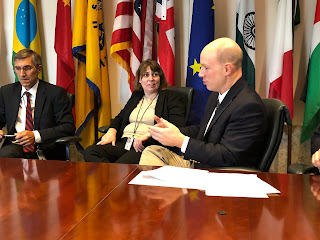This is my perspective.
I'm going more into the weeds than I did when I live-tweeted from the meeting, but I think that it is important that advocates' meetings with the FDA are open books, and I think that different people see things through different lenses.
My pictures. My lens. My perspective.
On Thursday, September 26, a contingent from I Am ALS held a followup to their February meeting with the FDA. The meeting was on the FDA White Oak Campus in a conference room that was filled to the gills.
The agenda for the meeting was distributed to the FDA in advance. It was a businesslike agenda that was to include action items and next steps. The agenda had been adjusted to be productive in light of the release of the FDA Guidance for Industry on ALS which was released a few days earlier.
The meeting was set as a one-hour meeting. It was clear that there was a hard stop at one hour. That is not unusual for any business meeting and the agenda was designed to respect that.
Advocates were taken to the meeting room and I sat at the large oval table across from some seats that were reserved for FDA staff. At 1pm when the meeting was to start, a contingent from the FDA including Acting FDA Commissioner Sharpless, Dr. Marks, and Dr. Dunn entered and sat in those chairs across from me. I took the picture immediately before the meeting started.
I was truly surprised to see Dr. Sharpless there. He immediately spoke to the FDA's and his personal commitment to ALS. He lost a cousin to it at a young age. He personally knows Dr. Cudkowicz. He gets it. He told us he would only be at the meeting for a short time but offered to address any questions. That was impressive. There were no direct questions. There was gratitude for his interest and presence (including my gratitude).
When Dr. Sharpless left, Dr. Marks and Dr. Dunn were the ranking FDA officials at the meeting. Dr. Marks advised us that his time in the meeting would be limited.
The I Am ALS Advocates' agenda began. The theme was that our work has just begun. I agree with the theme. The Guidance was a solid launching pad and now we need to launch with trial sponsors.
The overview of the Guidance was skipped for the sake of time. As was mentioned at the meeting, everyone there had probably read it 17 times already.
The gaps were the most challenging part of the meeting. After some discussion, Dr. Marks departed as explained.
Discussion of the gaps continued. As with any meeting when there is a fire for change and limited time, the clock marched on far too fast. Isn't that always the way it is with ALS, though?
Dr. Dunn was completely supportive of the Interim Analysis approach that would not corrupt the trial as long as it is designed into the trial up front. As a regulator he is well aware of the slippery slope that post hoc analyses provide, and the FDA is quite open to interim analysis as long as there is a plan up front. This is another opportunity for us to demand change from sponsors.
Time moved on. Discussion of heterogeneity ensued. Dr. Dunn suggested that they are well aware that heterogeneity has been the bane of many a trial. He also suggested that concepts such as re-randomization aren't new to the FDA and that there was no need to get into the weeds. They approve such concepts in trials and we need for sponsors to bring them something. We have yet another opportunity to demand change from sponsors. The FDA can't act until somebody brings them a trial design.
Finally as time was running out to finish the agenda. the rich source of possible controls in the PRO-ACT database was explained. Again, Dr. Dunn acknowledged affirmatively and suggested that we didn't need to spend more time on the discussion. Again, the ball is in our court to get sponsors on board.
This is the fourth meeting I have attended that included Dr. Dunn. He is a man of few words. He has the poker-face that is typical of an FDA official. At this meeting my perspective was that he was engaged and wants us to succeed in changing ALS trials, but we need for sponsors to do their part.
As we were almost out of time, we got to an important discussion point on how we get people with ALS at the table in sponsor meetings with the FDA. A key suggestion was that the FDA simply ask, "Who among you is the person with ALS?" when a sponsor meets with them. Advocates wanted support from the FDA to set an expectation even though the FDA can't require a person with ALS be in those meetings.
Finally, even though the FDA supportive position on Expanded Access Programs or Right to Try access is established, advocates asked that such access be specifically encouraged in meetings with sponsors.
Dr. Dunn emphasized that the final ALS Guidance document wasn't a reaction to any one group, but rather it was based on the contributions of many.
We anticipate some form of followup meetings with this group and the FDA.
My perception was that we had a businesslike and productive meeting on Thursday. Our work has just begun to change sponsors' approach to ALS trials and to become part of discussions that sponsors have with the FDA. We finally have a Guidance document to be the basis for that.
My pictures. My lens. My perceptions.










